-
PDF
- Split View
-
Views
-
Cite
Cite
L. Keer, D. I. Jones, Developing a model for neutron star oscillations following starquakes, Monthly Notices of the Royal Astronomical Society, Volume 446, Issue 1, January 2015, Pages 865–891, https://doi.org/10.1093/mnras/stu2123
Close - Share Icon Share
Abstract
Glitches – sudden increases in spin rate – are observed in many pulsars. One mechanism advanced to explain glitches in the youngest pulsars is that they are caused by a starquake, a sudden rearrangement of the crust of the neutron star. Starquakes have the potential to excite some of the oscillation modes of the neutron star, which means that they are of interest as a source of gravitational waves. These oscillations could also have an impact on radio emission. In this paper, we make upper estimates of the amplitude of the oscillations produced by a starquake, and the corresponding gravitational wave emission. We then develop a more detailed framework for calculating the oscillations excited by the starquake, using a toy model of a solid, incompressible star where all strain is lost instantaneously from the star at the glitch. For this toy model, we give plots of the amplitudes of the modes excited, as the shear modulus and rotation rate of the star are varied. We find that for our specific model, the largest excitation is generally of a mode similar to the f-mode of an incompressible fluid star, but that other modes of the star are excited to a significant degree over small parameter ranges of the rotation rate.
1 INTRODUCTION
Neutron stars normally rotate at an extremely regular rate. Once the steady slowdown over time from magnetic dipole radiation is accounted for, pulsars can keep time to an accuracy of one part in 1011 or more (Lyne & Graham-Smith 1998). However, younger pulsars often display more erratic behaviour. Some of this variation comes from timing noise, small unmodelled deviations in the pulse period. More dramatically, many have been observed to undergo a sudden speed-up in rotation rate, known as a glitch.
Glitch observations are discussed in detail in Espinoza et al. (2011), where glitching pulsars are shown to exhibit a diverse range of behaviours. The size of a glitch can be characterized by the fractional change in spin frequency |$\frac{\Delta \Omega }{\Omega }$| of the pulsar. Glitches have been observed spanning the range |$\frac{\Delta \Omega }{\Omega }\sim 10^{-11}-10^{-5}$|, and the distribution of glitch sizes experienced by an individual pulsar also varies widely. Some pulsars, such as the Vela, undergo ‘giant’ glitches of approximately regular size with |$\frac{\Delta \Omega }{\Omega }\sim 10^{-6}$|, whereas some of the youngest pulsars such as the Crab have smaller glitches with |$\frac{\Delta \Omega }{\Omega } \lesssim 10^{-8}$|, and glitch sizes are distributed over a wide range (Wong, Backer & Lyne 2001).
Glitches are likely to excite oscillation modes of the star, making them an interesting candidate source for gravitational wave emission. These oscillations could also be expected to shake the star's magnetosphere, leading to the possibility of radio emission observable by next generation radio telescopes. The increased sensitivity and time resolution of the Square Kilometre Array may allow the glitch event to be detected directly.
However, the nature and amplitude of the oscillation modes excited will depend strongly on the mechanism producing the glitches, which is as yet unknown. The leading explanation for the larger glitches is that they are caused by a rapid transfer of angular momentum from the superfluid component of the star to its crust (Anderson & Itoh 1975). This superfluid component may ordinarily be only weakly coupled to the crust, which gradually slows down through magnetic braking. This is because the superfluid can only slow down through the outward migration of its quantized vortices. As they reach the solid crust they may become pinned to the nuclei in the crystal lattice, fixing the angular momentum of this part of the superfluid. A glitch would then be triggered by an event that could increase the coupling between the two components by producing a sudden collective unpinning of these vortices. Various mechanisms for this unpinning have been proposed (Alpar et al. 1984; Melatos, Peralta & Wyithe 2008; Glampedakis & Andersson 2009).
Another idea is that glitches are produced by a starquake – a sudden rearrangement of the crust of the star (Baym & Pines 1971). This model uses the fact that while a fluid star would be able to freely adjust its shape as the neutron star slows down over time, the solid crust of a neutron star will resist the deformation from its relaxed state; consequently, it will stay more oblate than a fluid star would. The level of strain in the crust builds up, and this may reach a critical value at which the crust can no longer withstand the strain and breaks. The release of strain means that the star loses some of its residual oblateness. The moment of inertia decreases, and so by conservation of angular momentum there must be a corresponding increase in the star's angular velocity, producing the observed glitch. This model is not able to produce a large enough energy release to account for the largest glitches, such as those of Vela (Alpar et al. 1996), but is still promising for describing smaller glitches such as those of the Crab.
The prospects for gravitational wave detection from the superfluid model have been discussed in papers by Sidery, Passamonti & Andersson (2010) and van Eysden & Melatos (2008). In this paper, we will concentrate on the starquake model, starting by making some order-of-magnitude estimates for the maximum energy released in a starquake, and the amplitudes of the oscillations produced, using a formalism originally developed by Baym & Pines (1971). We then develop a more detailed framework for calculating the oscillations excited by a glitch, based on calculating initial data for the glitch and projecting it against a basis of normal modes of the star. We carry this out for a toy model in which the star is completely solid and incompressible, and the glitch is modelled by an instantaneous loss of all strain. Although this acausal glitch mechanism is not realistic, it is a sensible starting point which allows us to develop the model, and even this simple model produces some interesting results.
We will start in Section 2 by giving an overview of our model for a starquake and fixing notation for the rest of the paper. In Section 3, we make order-of-magnitude estimates of the amplitude of oscillations produced by the quake, both for our specific model and for an optimistic scenario in which all energy released in the quake goes into oscillations. For this scenario, we also calculate the gravitational wave emission produced by the oscillation, both for an ordinary neutron star with a fluid interior and a solid quark star. We then move on to the more detailed model, describing the calculation of the initial data for the glitch in Section 4 and the normal modes of the rotating star in Section 5. In Section 6, we develop a projection scheme that allows us to calculate the amplitudes of the oscillation modes excited, and discuss the results of this. Section 7 then provides a summary of the results of the paper.
2 THE STARQUAKE TOY MODEL
In this section, we describe our simplified toy model for a glitch. This is illustrated in Fig. 1, where the main stages of the glitch are labelled as Stars A–D. We will work in Newtonian gravity throughout the paper. We will also only consider the case of slow rotation, in which rotation is treated as a perturbation about a spherical background star (Star S of the figure).
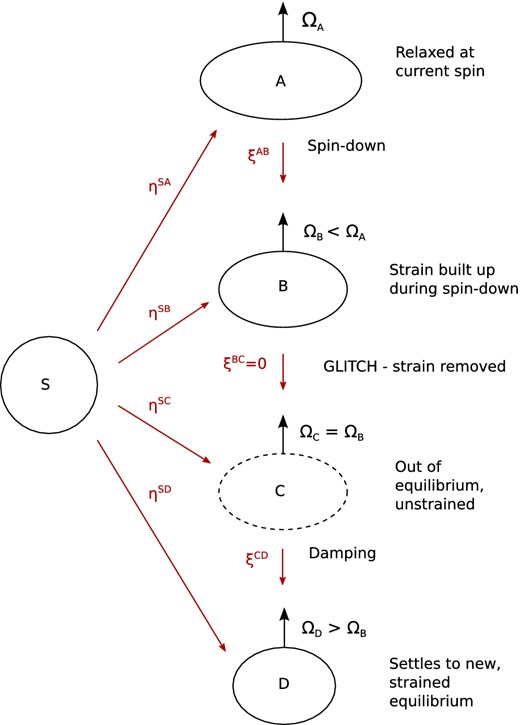
Diagram of our starquake model. As the star spins down from an initial, relaxed configuration (Star A) spinning at angular velocity ΩA, strain builds up in the crust. When this reaches a critical level (Star B) at some angular velocity ΩB, the crust cracks and strain is removed. Immediately after the starquake the star is out of equilibrium (Star C), and oscillates briefly before settling down to a new equilibrium state (Star D) spinning with angular velocity ΩD. We will treat the equilibrium states as perturbations about a spherical background configuration, Star S. The maps η track the displacements of particles in S to their new positions in Stars A–D, while the ξ displacement fields map between A and D.
In this toy model, we take our star to be completely solid and incompressible: this will allow us to use analytic results for the equilibrium configurations of the rotating star, and for the normal modes of Star S. The star is also modelled as an elastic solid, so that it has some relaxed state of zero strain, and deformation from this state will induce a strain field in the star. This strain field is built from the displacement vector field |$\boldsymbol {\xi }$| connecting points of the star in its relaxed configuration to their new positions in its current configuration.
In our model, the star starts in an unstrained state, Star A, spinning with angular velocity ΩA. In this relaxed state, the star will have the same shape as a completely fluid star. This star will then spin-down as it loses energy. This will cause it to become less oblate, inducing a strain field in the star as it is deformed from its relaxed configuration. The starquake then occurs at the point where the strain has built up to some critical level where the crust can no longer support it – we label this as Star B, which is spinning at some angular velocity ΩB. The strain field at this point can be calculated from the displacement field that connects particles in the unstrained Star A to their new positions in Star B, which we will label |$\boldsymbol {\xi }^{{\rm AB}}$|.
We now need to specify our model of the glitch itself. For our toy model, we will take the extreme case where all of the strain energy of Star B is lost from the star. More precisely: ‘We assume that all the strain is lost from the star at the glitch, so that the new, unstrained reference state of the star is that of Star B. Furthermore, we assume that this energy is just lost from the star as heat, rather than going into kinetic or gravitational energy. This means that the mass distribution of the star will not be changed at the glitch – particles in Star C immediately after the glitch are not displaced from their positions in Star B: using the same labelling method for the displacement field between Stars B and C, we have |$\boldsymbol {\xi }^{{\rm BC}} = 0$|.’
After the glitch, the star will now be out of equilibrium (Star C), and so it will start to oscillate. These oscillations will be damped until the star finally reaches a new equilibrium configuration, Star D, with angular velocity ΩD. This equilibrium state is deformed from its unstrained state, Star C, and so has some residual strain constructed from the displacement field |$\boldsymbol {\xi }^{{\rm CD}}$|.
2.1 Plan of the calculation
The basic idea of our starquake model is to project initial data describing the starquake against the set of oscillation modes of the star after the glitch, in order to find the amplitudes of the excited oscillation modes. This process has three stages.
First we construct the initial data, which will take the form of a displacement field |$\boldsymbol {\xi }^{{\rm DC}}$| and velocity field |$\dot{\boldsymbol {\xi }}^{{\rm DC}}$| describing how particles in the star are perturbed from equilibrium after the glitch. Note that the initial data links the final state, Star D, to the state of the star before the glitch, so the displacement field initial data is in the opposite direction to the strain field |$\boldsymbol {\xi }^{{\rm CD}}$|. This construction will involve finding the new equilibrium state of the star after the starquake, Star D, which is rotating with angular velocity ΩD. We do this in the case of slow rotation, where the change in the star's equilibrium configuration due to rotation is treated as a perturbation about the spherical background star, Star S.
Next, we calculate the spectrum of oscillation modes of Star D. We will start by finding analytic results for the eigenvalues and eigenfunctions of the spherical Star S. We then introduce rotation as a perturbation and calculate the first-order corrections to these modes.
Finally, we can project our initial data, |$\boldsymbol {\xi }^{{\rm DC}}$| and |$\dot{\boldsymbol {\xi }}^{{\rm DC}}$|, against this set of modes of Star D, to see which ones are excited by it. The eigenfunctions of Star S are orthogonal, which we show in Appendix B. However, once we include rotation, this is no longer the case. We describe a scheme that will nevertheless allow us to carry out the projection.
3 ENERGY ESTIMATES FOR THE MODEL
In the specific model outlined in the previous section, the strain energy is just lost from the star at the glitch. In this case, the energy available to go into oscillations comes only from the change in the star's gravitational and kinetic energy as it settles to a new equilibrium state. This is the energy difference between Stars C and D, ΔECD = EC − ED.
Although this is perhaps the simplest option to model, it is not necessarily the most realistic. We can also imagine taking the strain energy of the star before the glitch and putting some of it into, for example, the kinetic energy of the star after the quake (if the crust cracks or otherwise moves about).
The upper bound on this would be to put all the strain energy made available into gravitational or kinetic energy. This would correspond to the total energy immediately after the glitch being that of Star B. This gives us an upper limit on the energy available to go into oscillations at the glitch, ΔEBD = EB − ED.
3.1 Energies released in the starquake
3.2 Estimates for solid quark stars
The estimates given so far have been for a normal neutron star with a crust around 1 km thick. More exotic models have however been proposed, including quark stars with a large solid core (Glendenning 1996; Xu 2003). These models are of interest in terms of gravitational wave emission, as they are expected to be able to sustain a larger maximum ellipticity (Owen 2005; Haskell et al. 2007; Lin 2007). More relevant to us here is the possibility that a solid star of this type could be expected to undergo a much larger quake.
To summarize, in this section we have made estimates of the amplitudes of the oscillation produced in a starquake, both for our toy model and a more optimistic scenario where all the energy released in the glitch goes into mode oscillations. We have found that in this optimistic case, amplitudes of 10−6δR/R can be excited at the surface of the star, for the case where the star spins down by a large amount at the glitch (X ∼ 1). For our specific toy model where the strain energy is lost at the glitch, we find that these amplitudes are suppressed by a factor of |$\sqrt{b}$|. We then briefly considered how these estimates were altered in the case of a solid quark star, where bsolid could be as large as 10−2, allowing for much larger glitches. In this case, the upper bound from the optimistic scenario gives amplitudes of 10−2δR/R.
4 CONSTRUCTION OF THE INITIAL DATA
5 OSCILLATION MODES OF THE ROTATING STAR
In this section we will find the spectrum of eigenvalues and associated eigenfunctions for Star D; we will later project the initial data of Section 4 against these eigenfunctions to find which modes are excited. We will start by calculating the oscillation modes of the spherical star, Star S. This problem was first studied for the constant density case we are interested in by Bromwich (1898). We will first restate the problem and summarize his analytic results for the eigenvalues and eigenfunctions, and then carry out a further numerical investigation of these results. Next, we will make the slow rotation approximation and consider rotation as a perturbation about this background model.
An alternative approach would be to start by computing the oscillation modes of a rotating fluid star, and then adding elasticity as a small perturbation. We instead chose to use the exact results of Bromwich we had available for the non-rotating elastic star.
5.1 Oscillation modes of the spherical background star
To further investigate the eigenvalue spectrum and associated eigenfunctions, we will need to carry out some of the work numerically. We will find spheroidal and toroidal eigenvalues by finding roots of the non-linear functions fS (equation 86) and fT (equation 91). We can then plot the corresponding eigenfunctions by using these eigenvalues in conjunction with the analytic forms of the radial functions U (equation 87), V (equation 88) and W (equation 92).
To illustrate this, in this section we will specialize to the case of l = 2, m = 0 modes. These are the most important for our glitch model, as our initial data for the displacement field (equation 78) has a P2(cos θ)-dependence which matches that of the l = 2 eigenfunctions.
In general, we can parametrize our background stars by their radius, density and shear modulus (R, ρ, μ). We can make an arbitrary rescaling of the first two, as for given l, the only free parameter in the function fS (equation 86) used to determine the eigenvalues is the ratio |$\frac{\mu }{\rho }$|.
We can then plot the scaled l = 2 eigenvalues |$\frac{[(\omega _{\rm S})^{ln}]^2}{\omega _{\rm K}^2}$| as a function of b; the first 30 of these are shown in Fig. 2. Concentrating on a given value of b, we can see the start of an infinite set of eigenvalues, which we label with the radial eigenvalue number n in order of increasing frequency. The squared frequency ω2 scales linearly with b and hence with the shear modulus μ: this is typical of modes of an elastic solid, which have frequency |${\sim} \scriptscriptstyle\sqrt{\frac{\mu }{\rho }}$|. The exception to this is the behaviour of the modes closest to the fluid Kelvin mode ωK. Around this value, we see avoided crossings between modes. This is characteristic of systems where two different types of mode have a similar frequency (Aizenman, Smeyers & Weigert 1977): in this case these are the single fluid-like mode close to the Kelvin mode frequency, and one of the elastic modes of the star.
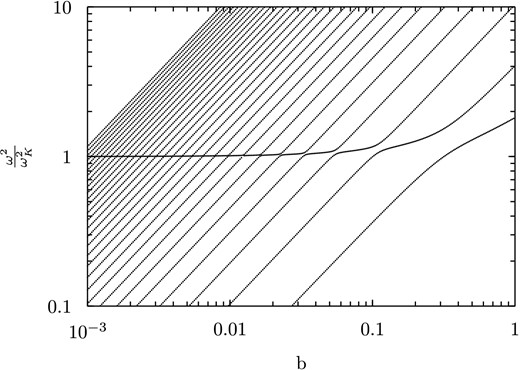
Plot showing how the l = 2 mode frequencies of an incompressible elastic star vary with the ratio of strain to gravitational energy b. On the y-axis, frequencies are scaled by the fundamental l = 2 Kelvin mode of an incompressible fluid star, ωK. For typical neutron star parameters, ωK ∼ 2000 Hz. For a given value of b, the lowest-order modes have a similar character to those of an elastic solid, scaling as |$\sim \sqrt{\frac{\mu }{\rho }}$|. There is one mode around |$\frac{\omega }{\omega _{\rm K}}=1$| with a hybrid fluid-elastic character, and then the higher modes again have an elastic character.
Next, we can use these eigenvalues to calculate the corresponding toroidal and spheroidal eigenfunctions. Fig. 3(c) shows a plot of the first 10 toroidal eigenfunctions for b = 0.01. The lowest, n = 1 eigenfunction has no nodes; each eigenfunction gains one more node with increasing n.
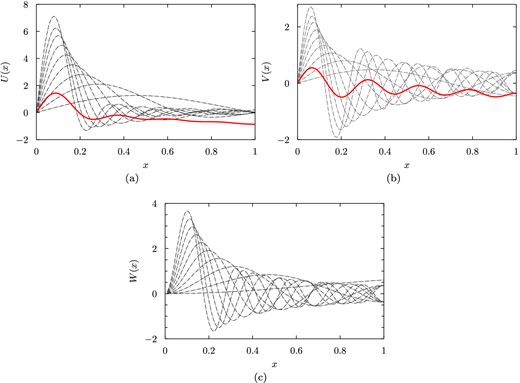
Figure showing the U, V and W radial parts of the first ten l = 2 spheroidal and toroidal eigenfunctions for the case b = 0.01, as a function of the fractional radius |$x=\frac{r}{R}$|. (a) Plot of the U radial part of the first 10 spheroidal eigenfunctions. The hybrid fluid-like mode is marked in solid red; the other eigenfunctions (dashed lines) have an elastic character. (b) Plot of the V radial part of the first 10 spheroidal eigenfunctions, with the hybrid fluid-like mode marked in solid red. (c) Plot of the W radial part of the first 10 toroidal eigenfunctions.
The spheroidal eigenfunctions display more complicated behaviour. As an example, Figs 3(a) and (b) show the U and V parts of the first 10 eigenfunctions for b = 0.01. The majority of the eigenfunctions, shown as grey dashed lines, are of elastic type. These form an ordered sequence with the lowest n = 1 mode having one stationary point, the n = 2 mode having two, etc. These modes also have a very small amplitude at the surface.
The eighth eigenfunction, marked as a solid red line, has a frequency just above ωK and exhibits very different behaviour to the rest of the set. In particular, it has a much larger amplitude at the surface. This is consistent with this eigenfunction having a hybrid fluid-elastic character: the overall shape of the eigenfunction is similar to the linear l = 2 Kelvin mode eigenfunction for a completely fluid star (equation 94), while the elastic character of the mode is evident in the oscillations superimposed on this.
This behaviour is generic for all values of b in the range b = 10−6–1 that we have studied. As b gets smaller, the gap between mode frequencies gets smaller, so that the single hybrid mode is pushed to higher n. By b = 10−6, the hybrid mode is at n = 877. For lower values of b, where the star is closer to a fluid star, we should expect the hybrid eigenfunction to approach that for a fluid star. This is indeed what we see in Fig. 4, where the hybrid mode is plotted for four different values of b. In the l = 2 case, the fluid Kelvin mode eigenfunction (equation 94) has a linear U component; the hybrid modes approach this form as b becomes smaller.

Plot showing the U radial part of the l = 2 hybrid fluid-like mode for b varying from 10−1 to 10−4. As b is made smaller, the form of the eigenfunction becomes closer to the linear eigenfunction of an incompressible fluid star.
Another way to obtain some insight into the behaviour of the eigenfunctions is to pick a value of n and track the variation of the eigenfunction with b. As an example, Fig. 5 is a surface plot for n = 3, showing how the U part eigenfunction changes between b = 10−3 and 1. We can see that the eigenfunction changes continuously, but goes through three distinct phases. For the smallest values of b on the right, the three lowest eigenfunctions are all elastic-type eigenfunctions, and so the n = 3 eigenfunction is the third elastic eigenfunction with three stationary points. As b gets larger there is a transitional area where the third mode has a hybrid character. For values of b larger than around 0.1, the hybrid mode is found at n = 1 or 2, and so the n = 3 eigenfunction is again an elastic-type function, this time the second such function with two stationary points. The contours projected on to the base of the graph show how the zeroes of the eigenfunction vary with b. This makes it clear that the intermediate, hybrid eigenfunction has a very different character, with no zeroes.

Surface plot showing how the U radial part of the n = 3 eigenfunction varies with b. The eigenfunction goes through three distinct phases: in the middle region around b = 0.1 there is a transitional area where this mode has a hybrid fluid-elastic character. The contours projected on to the base of the graph show the zeroes of the eigenfunction; there are none for the hybrid mode.
5.2 Rotating star
To model mode excitation of a glitching star, we will also need to account for the fact that the star is rotating. In this section, we will add the effects of rotation in to our computation of the oscillation modes of our model.
We will assume that the star is rotating slowly, in the sense that the centrifugal force is small compared to the gravitational force at the surface of the star; this is a reasonable assumption for most pulsars. This approach was used for fluid stars by Cowling & Newing (1949), and has also been developed in the geophysics literature (Backus & Gilbert 1961; MacDonald & Ness 1961; Pekeris, Alterman & Jarosch 1961). Here, we will mainly use the method of Strohmayer (1991). However, we will use somewhat different notation in our paper, based on that of Friedman & Schutz (1978), so it will be helpful to restate some of the main results in this notation.
To calculate these corrections numerically, we again scale our equations so that the star has unit radius R = 1, and that the l = 2 fluid Kelvin mode has ωK = 1. With this choice, the parameter σ* (equation 100) becomes |$\sigma _* = \frac{\sqrt{5}}{2}$|.
The analytic expressions for the corrected eigenfunctions (114) and (115) include an infinite sum over the radial eigenvalue number n. For numerical work we will need to truncate these eigenfunctions, calculating the sum only up to some maximum value N. We will label these truncated eigenfunctions as |$\boldsymbol {S}^\alpha _N$| and |$\boldsymbol {T}^\alpha _N$|.
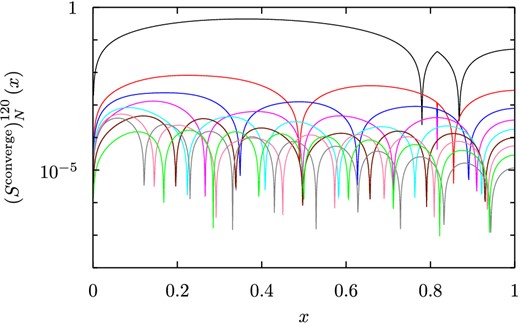
Figure showing the convergence of the rotational corrections to the spheroidal l = 2, n = 1 eigenfunctions for b = 10−1, as the corrections are truncated at progressively higher values of the radial eigenvalue N. In particular, the ϕ component of the functions |$(S^{{\rm converge}})^{n20}_N$| (equation 116) is plotted for N = 1 (plotted in black) up to N = 9 (plotted in green).
6 PROJECTING THE INITIAL DATA
Before considering the full problem, we can get some useful insight from the special case where the star spins down to zero angular velocity (ΩB = 0) before the ‘glitch’, modelled as a sudden loss of strain from the star. Although this is not a realistic model – we have lost the key observational feature of the glitch, the change in rotation rate of the star – there are good reasons to discuss this first. For a start, it is easier to interpret the results for this simpler case, and certain features of these will carry over to the more realistic case where the star is still rotating before the glitch. We can also check that the results for the rotating problem converge to the non-rotating one as rotation becomes small.
Another reason for considering the non-rotating problem first is that the rotation of the star introduces significant complications to the projection scheme. One of these is that the eigenfunctions of the rotating star are no longer orthogonal. Another is the existence of the zero eigenvalue l = 1 toroidal mode (equation 118) that our velocity initial data is built from. As this mode is zero frequency, it will not have the eiωt time-dependence of the other eigenfunctions and we will have to consider it separately. We will discuss these problems in Section 6.2.
6.1 Special case: glitch at zero spin

Figure showing the results of the projection for different values of b. For clarity, individual vertical bars are not displayed for plots (c)–(f). The x-axis shows the radial number of the mode, while the y-axis shows the amplitude of that mode. The hybrid fluid-elastic mode has the largest amplitude; this becomes more pronounced as b is made smaller.
6.2 The general case: glitch at arbitrary spin

Schematic showing how the zeroth-order modes couple to other modes at first order in rotation. The displacement field has an l = 2 form and couples to l = 1 and 3; this is shown in blue. The velocity field, shown in red, has the form of a zero-frequency l = 1 mode; it has no rotational corrections. The other modes in the range we are considering are also shown. The l = 1 modes only couple to l = 2, while for the l = 3 modes, only the l = 2 coupling falls into the considered range.
6.3 Results of the projection
We carried out the projection using this numerical scheme for the cases b = 10−1, 10−2, 10−3. As with the calculation of the rotational corrections of the eigenfunctions, we cut off at N = 10, 15 and 40 respectively, with these values chosen so that the hybrid fluid-elastic mode is within the range for each case. The increasingly high n value of this mode for small b, and the fact that the calculation of the 6N × 6N Λ matrix is computationally intensive, meant that we did not investigate any smaller values of b.
For given b, we also need to consider what parameter range of t our scheme is valid for. We have used the slow rotation approximation to calculate the modes. Considering the form of the eigenvalue equation for the rotating star (equation 98), we can expect this to be a good approximation when ω2A is large compared to εωB, i.e when |$\frac{\Omega _{\rm B}}{\omega }\ll 1$|. We have |$\Omega _{\rm B} \sim \sqrt{t}$|, but we also have to take into consideration which mode ω we are looking at. The elastic modes scale with b, so that for the lowest modes with small n value we need |$\frac{\sqrt{t}}{b}\ll 1$|. The hybrid fluid-like mode has a scaling |$\sqrt{G\rho }$| – we have scaled our numerical results so that this is of order unity, so for this mode we only need |$\sqrt{t}\ll 1$|.
The results for b = 10−2 are shown in detail as an illustrative example. In this case, we only have |$\frac{\sqrt{t}}{b}<10^{-1}$| for t < 10−4), so cannot expect our results to be reliable for the lowest n modes when t is larger than this. Around the n = 8 hybrid fluid-elastic mode, we can instead expect the results to be reliable when |$\sqrt{t}$| is small, i.e. from around t = 10−2 onwards.
Fig. 9 shows the calculated amplitudes of the modes for values of log10t = −1, −2, …, −6. These amplitudes are non-zero for the spheroidal l = 2 and toroidal l = 1 and 3 cases. For the spheroidal l = 2 and toroidal l = 1 cases, the first 15 modes are shown, while for the toroidal l = 3 modes the cut-off is at n = 14, because our numerical scheme does not reproduce the highest l = 3 mode correctly. To test this, we tried cutting off at lower values of N, and found that the l = 3, n = N mode is then not correct; to obtain the n = 15 mode we would have to cut off at N = 16.
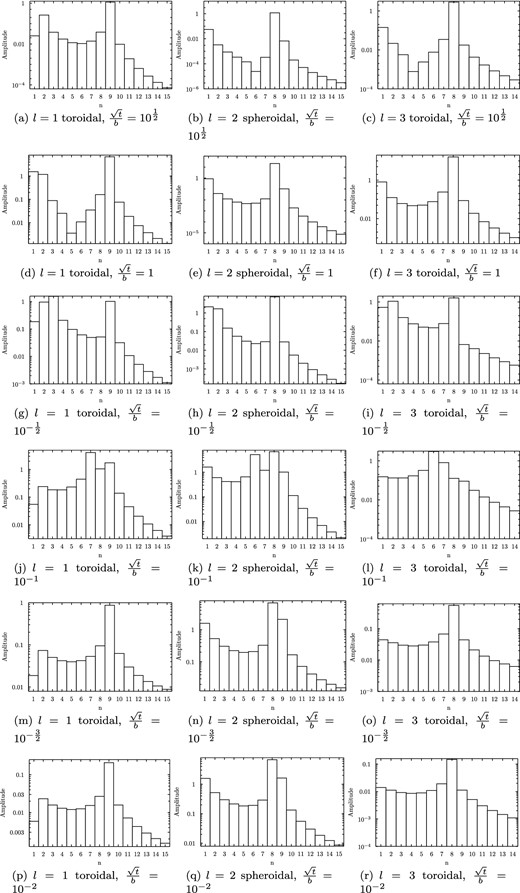
Figures showing the amplitude of each excited mode for the case b = 10−2 and log10t = −1, …, −6, where we have cut off at radial eigenvalue N = 15.
As a first consistency check, we can see that as t is made smaller, the results reproduce that of the non-rotating case: below t = 10−5, the l = 2 spheroidal amplitudes become very similar to those when t = 0, shown in Fig. 9(e), while the l = 1 and 3 amplitudes appear to roughly scale with |$\sqrt{t}$|, as would be expected from the size of the rotational corrections (equation 101) to the first-order eigenfunctions.
For t ≥ 10−4, the modes excited vary considerably from the non-rotating case, and there is no clear pattern visible in the figure. We can obtain greater insight by instead focusing on one mode at a time, and tracking the amplitude as a continuous function of t; this is shown in Fig. 10 for the lowest n modes (n = 1, 2, 3) and also for some values of n around the hybrid mode (n = 7, 8, 9). The amplitude is plotted on the y-axis, while the x-axis shows −log10t.
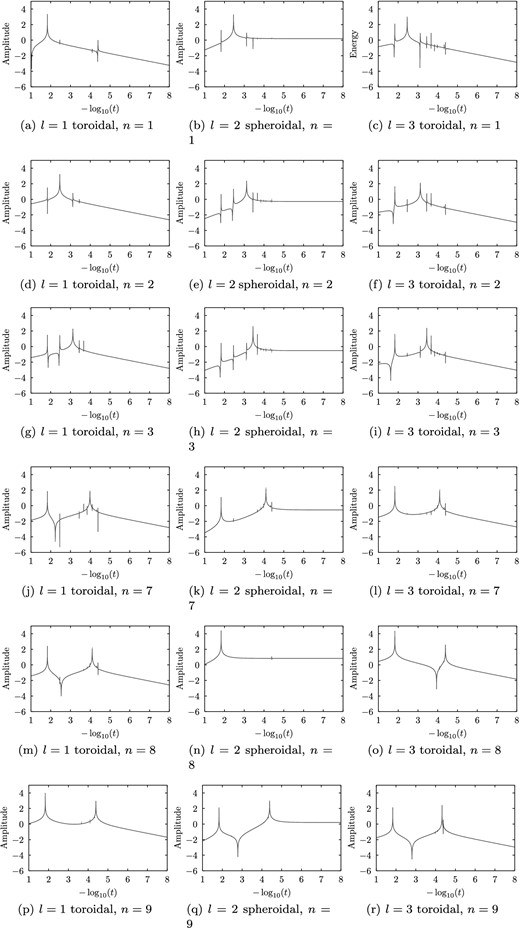
Figures showing how the amplitude in each mode varies with t for b = 10−2. The lowest-order modes are shown (n = 1, 2, 3), along with those around the n = 8 hybrid mode (n = 7, 8, 9). Amplitude is plotted on the y-axis, while the x-axis shows −log10t.
For the l = 2 modes, we can again see that as t is made smaller, the amplitude converges to that of the non-rotating case, while the l = 1 and 3 modes drop off with |$\sqrt{t}$| as expected. For each mode, this happens once |$\frac{\sqrt{t}}{b} \ll 1$|. However, for higher values of t, there are a number of ‘spikes’ in the amplitude in each mode, small parameter ranges of t over which the amplitude changes rapidly. We currently have no clear explanation for the existence of these spikes, but have checked these are stable under the choice of cut-off N: as N is made smaller, some of the detailed features are lost, but the larger spikes remain. We also see somewhat different behaviour for the hybrid n = 8 mode, with fewer spikes in the amplitude.
A similar picture holds for b = 10−1 and 10−3. Fig. 11 shows a few representative plots of the amplitude of the l = 2 spheroidal modes for these cases. For b = 10−1, we have plotted the amplitudes of the n = 1, 2 modes and the n = 3 hybrid mode. Similarly, for b = 10−3 we plot n = 1 and 2, and the hybrid mode n = 27. In both cases we again see convergence to the non-rotating case once |$\frac{\sqrt{t}}{b} \ll 1$|. For b = 10−3, as with b = 10−2, the amplitude of the hybrid mode shows different, smoother behaviour as t is varied; this is not so apparent for b = 10−1, where the hybrid mode is less distinct from the other modes of the star.
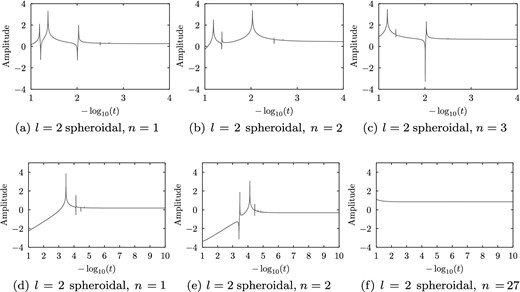
Figures showing how the amplitudes of the l = 2 spheroidal modes vary with t for b = 10−1 and 10−3. The lowest-order n = 1, 2 modes are shown in each case, along with the hybrid mode (n = 3 for b = 10−1, and n = 27 for b = 10−3). The amplitude is plotted on the y-axis, while the x-axis shows −log10t.
A final important check is that we can use the calculated amplitudes to reconstruct the initial data. This is shown in Appendix A.
7 CONCLUSIONS
We have made order-of-magnitude estimates of the maximum energy released in a starquake, finding maximum oscillation amplitudes of |$\frac{\delta r}{R}\sim 10^{-6}$| and characteristic strains of ∼4 × 10−24 Hz−1/2 in the upper limit where all energy lost in the glitch is put into oscillations. For the case of a completely solid quark star, we find larger maximum amplitudes of |$\frac{\delta r}{R}\sim 10^{-2}$| can be sustained, with corresponding characteristic strains of ∼5 × 10−22 Hz−1/2. In each case, these estimates are for a large change in the angular velocity of the star between glitches.
We have also developed a toy model for starquakes, in which all strain is suddenly lost from the star at the glitch. We first considered a simplified version in which the star is not rotating before the glitch, and found that the excited modes are l = 2 spheroidal oscillations. Out of these, the oscillation mode preferentially excited is a hybrid fluid-elastic mode similar to the Kelvin mode of an incompressible fluid star. The addition of rotation introduces excitation of l = 1 and 3 toroidal modes of the star. The hybrid mode is still strongly excited, but other modes of the star with an elastic character are also excited to a high level over small parameter ranges of the rotation rate; we currently have no clear explanation for this behaviour, but have tested it is stable under changing the number of radial modes we include in the set we project against.
To move from our current toy model to a more realistic model of a starquake, there are a number of extensions we need to consider. First, we would need to include the fluid core of the star in our model. This would complicate the spectrum of oscillation modes by adding extra ones connected to the fluid-elastic interface. We could also consider using a more realistic equation of state rather than our incompressible model, introducing new p- and g-modes to the mode spectrum.
It would also be necessary to improve the model for the starquake itself. At the moment, we have an acausal mechanism in which all strain is lost from the star instantaneously. In a realistic scenario, the quake would propagate across the star over time, possibly in the form of surface cracks. The new time-scale introduced here could strongly affect which modes of the star are excited. However, this time-scale is not well-constrained observationally.
The oscillations produced by a starquake would be expected to shake the magnetosphere at the surface of the star, which could lead to radio emission connected with the starquake, possibly at a level that could be resolved with the new generation of radio telescopes. It would be interesting to make some estimates of this with a toy model of how the pulsar could shake magnetic field lines in the magnetosphere.
LK acknowledges support via an STFC PhD studentship, while DIJ acknowledges support from the STFC via grant number ST/H002359/1. The authors also acknowledge partial support from ‘NewCompStar’, COST Action MP1304.
REFERENCES
APPENDIX A: RECONSTRUCTION OF THE INITIAL DATA
In this appendix, we demonstrate that the amplitudes we calculate for the excited modes can indeed be used to reconstruct the initial data, both in the non-rotating special case and for the full problem for the rotating star.

Figure showing the reproduction of the initial data as a sum of eigenfunctions for the case b = 0.1. The U and V parts of the initial data are shown in the top row. In the middle row, the partial sums Upartial(N, x) and Vpartial(N, x) are shown for N = 1 (black line) up to N = 10 (green line); the largest contribution is from the N = 3 eigenfunction (dark blue), which is the fluid-elastic hybrid mode. The bottom row plots the absolute value of the difference between the partial sums and the initial data, Uconverge(N, x) and Vconverge(N, x).
Next we consider the full problem with rotation, where we also have to reconstruct the velocity initial data as well as that for the displacement. The velocity field initial data |$\dot{\boldsymbol {\xi }}^{{\rm DC}}$| (equation 118) is made up from only one zeroth-order eigenfunction, the zero frequency n = 1 toroidal mode, and this mode has no corrections at first order in the rotation. This means that the velocity initial data can be reconstructed from one eigenfunction only, and this can be done with close to numerical precision.
As an example of the reconstruction for the displacement field initial data, Fig. A2 plots the U part of the fractional difference between the initial data and its reconstruction (equation 151), |Ureconstruct(n) − UCD|/UCD, for b = 10−2 and t = 10−2, with values of n between 1 and the cut-off N. We see that as with the special case of the glitch at zero spin, the initial data is not reproduced correctly until the hybrid mode is added, and the reconstruction then converges to the initial data as N is made larger.
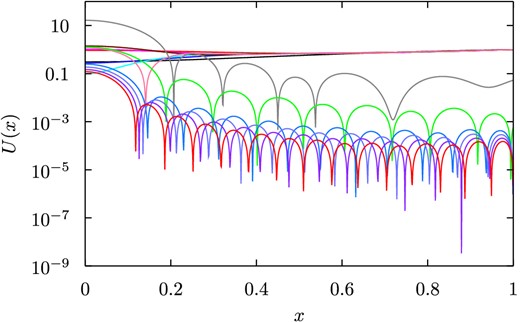
Figure showing the reconstruction of the initial data in the cases b = 10−1, 10−2 and 10−3, with t = 10−2. The U part of the fractional difference between the initial data and its reconstruction, |Ureconstruct(n) − UCD|/UCD, is plotted for values of n between 1 and the cut-off N. The initial data is not reproduced correctly until the hybrid mode is added, and the reconstruction then converges to the initial data as N is made larger.



